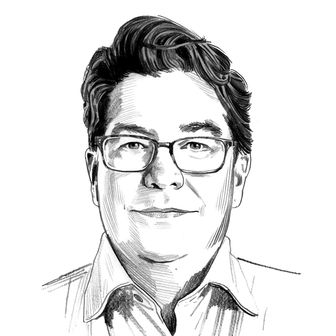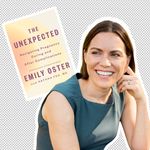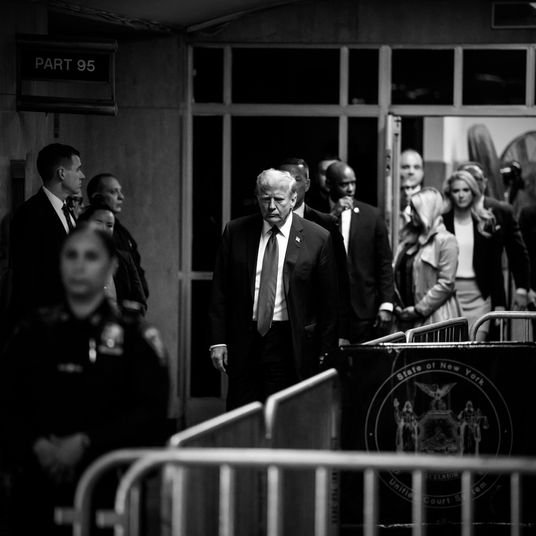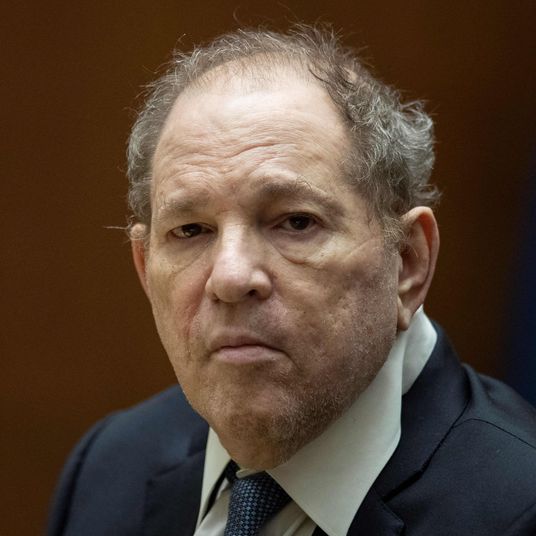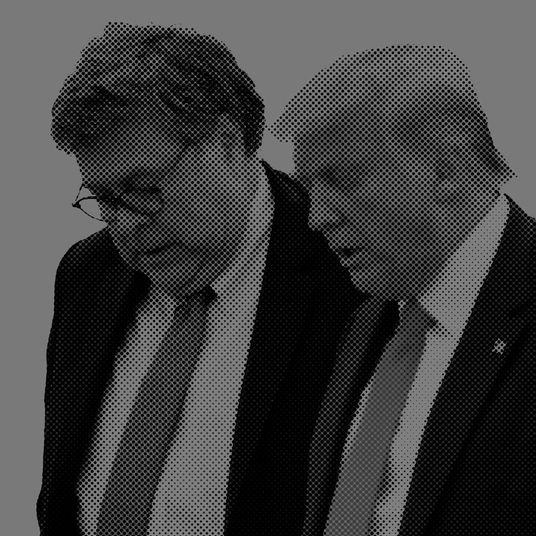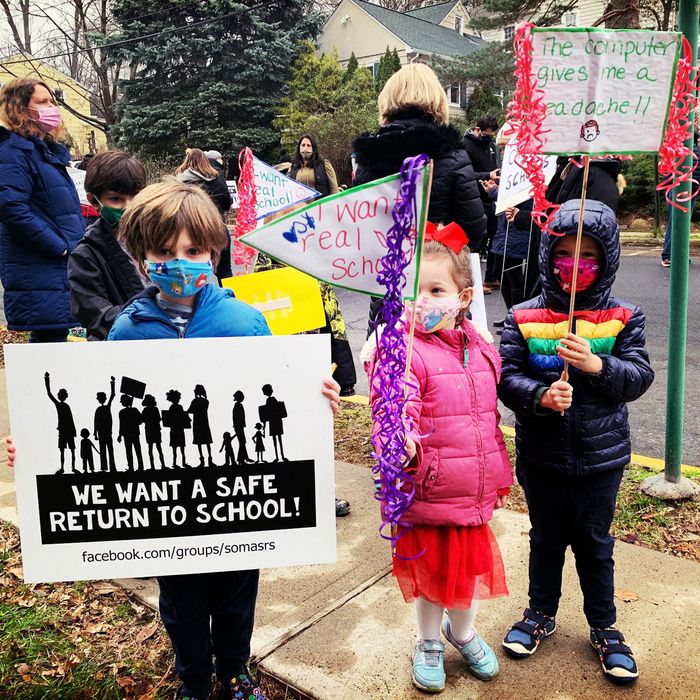
One drizzly Saturday in December, around a hundred suburbanites gathered in the New Jersey town of Maplewood for a scrupulously rule-abiding protest. “We have extra masks and hand sanitizer and extra wipes for everyone who needs them,” Julie Fry, an organizer, announced through a pink medical mask. Her microphone, which she’d disinfected with an alcohol towelette, was connected to a bullhorn a safe distance away, held by a woman wearing an L.L.Bean windbreaker and a mask that asked “WWRBGD?” They stood together as families, in well-spaced clusters, in front of a stone-faced public building.
Fry, a public defender, describes her political views as “left radical.” She used to be involved in the Occupy Wall Street movement back when she lived in Brooklyn, before she followed the migratory pattern that has brought so many other progressive young parents to Maplewood, a town of 25,000 that prides itself on its racial diversity and spirit of social activism. Fry’s politics fit seamlessly into the community for four years — until the pandemic hit and the public-school district serving Maplewood and neighboring South Orange shut down. It remained closed to in-person education, even as many neighboring districts — not to mention private schools, colleges, universities, bars, restaurants, churches, nail salons, gyms, shopping malls, yoga studios, and hockey rinks — managed to reopen.
The school district’s paralysis put Fry in an unexpected position, pitting her against many of her neighbors, as she made a divisive demand: She wanted her first-grader to go to school.
Every community has struggled with the question of whether and how to reopen classrooms. But the debate has taken on a particularly anguished dynamic in places like Maplewood, where no one would ever imagine being on the same side of an issue as Donald Trump. (Joe Biden won 90 percent of the vote here.) Before the coronavirus, people in the town seemed to share the same set of values, venerating education above all. As the cliché went, everyone had moved there for the schools. But once those schools were shut, this imagined consensus was ripped up. It seemed as if Maplewood could no longer agree on the most basic things: science, morality, the right thing to do.
At the December protest, children stood next to their parents and held signs that read “I Want to Meet My Teacher” and “Don’t Mute Me.” A little girl gripped a pennant on a stick: “I Want Real School.” One masked mom after another came forward, citing studies that suggest children are relatively less vulnerable to the virus and the recommendations of public-health experts who say reopening schools should be an overarching priority. “To ignore all of this evidence is to further children and families’ suffering with no rational justification,” one of the protest leaders said, reading from an online petition that now has more than 1,800 supporters, representing a decent percentage of parents in the district, which has around 6,900 students. “While we sympathize with fears of the unknown, we do not want to be driven by fear.”
The protesters questioned why other public-school districts in the area have managed to offer some form of in-person education, but not South Orange–Maplewood. They feared the long-term consequences — for their children and for the public-school system as a whole. “It could destroy the town eventually if schools don’t go back,” one parent, April Mason, told me at the protest. And yet Mason, a public-relations executive, said she raised her concerns reluctantly. “I’m a liberal, and I didn’t want to make a lot of noise about this issue,” she said. “It was almost like this whisper campaign.”
For months, the parents’ conversations about the issue had been mumbling and conflicted. They all agreed the situation was impossible for everyone. The district’s superintendent had been thrust into a once-in-a-century situation, and teachers, who were struggling so hard on the other end of the video streams, were genuinely worried for their lives. Some social-justice activists, who have an outsize influence in the community, were apt to say that anyone who discounted the risks of COVID-19, which has brutally impacted Black families, was speaking from a position of privilege. No one wanted to alienate their children’s teachers. No one wanted somebody to die. No one wanted to sound like Trump.
Then, suddenly — almost as soon as voters repudiated the president on Election Day — the tenor of the conversation shifted, and the demands grew bolder. “This is a fundamental right for my daughter, and for all the kids in the district,” Fry told me.
“Hear our voices, we want choices!” the crowd chanted as it marched down a hill, past the district’s only high school. Fry carried her 3-year-old daughter, Ruby, while her husband walked with their first-grader, Ceola. The march ended outside a state legislator’s office. “I want you all to know that we’re not alone,” Fry shouted through the bullhorn, still holding Ruby. “That there are protests going on right now in Montclair and West Orange and Nutley.”
Next to the legislator’s office, through the plate-glass windows of a fitness studio, I could see a group of masked women in a dance class. People were waiting outside a pizza place, which was serving lunch. Everything was open, somehow, except school.
The stresses of the pandemic have exposed the dysfunction lurking inside every American institution, but nowhere are its distorting effects more agonizing than in the realm of public education. The nation’s schoolchildren have been conscripted into a vast improvisational experiment, marked by geographic disparities that don’t seem to correlate to any calculation of risk. States with low-rated education systems, like Mississippi and Louisiana, have tended to hold classes like normal. In wealthy northeastern states like New Jersey and Massachusetts, which consistently sit atop the national rankings, many students are spending their days staring at glitchy laptops.
The students who most need education are receiving the least. An estimated 3 million children nationwide — many impoverished or homeless—are going without any form of school. With the notable exception of New York City, many of the nation’s large urban school districts remain remote, including all the ones in New Jersey. Over the summer, the New Jersey State Department of Education estimated that some 230,000 students in the state were unable to access online classes during the spring because they lacked computers or internet access. Although the hardware situation has improved, many students remain disengaged. In Camden, the superintendent recently estimated that a quarter of students are marked absent each day, compared to a 92 percent attendance rate before the pandemic. More than 20 percent of high-schoolers in Newark are deemed to be “severely chronic” absentees.
Everywhere, kids are losing motivation and logging out. “We’re seeing it at the high school too,” said Stacey Lawrence, who teaches creative writing at Columbia High, the one that Fry’s protest marched past. When we spoke in December, Lawrence told me she hated teaching via video, which she described as “Orwellian.” She knew that the cracks in the system were widening into chasms. “We are going to see huge disparities,” she said, “and I think it will continue.” Still, Lawrence was one of many teachers in the South Orange–Maplewood district who was opposed to returning to school until the pandemic abated. “Everyone wants it,” she said, meaning classroom learning. “But sometimes we can’t get what we want.”
I should acknowledge here that I, too, want something. As I write these words, I am sitting in my attic office, in the New Jersey suburb of Montclair — a town much like nearby Maplewood — looking out my window at the charming brick school building across the street, as the third-grader next to me fidgets in front of a Chromebook and a teacher he has never met prods him from a little square on the screen. I’ve spent the last few months watching with jealousy as friends in other towns, other states — even New York City, the place I lived before I moved here, for the schools — have posted photos of their kids heading to school in backpacks and masks. I can’t help but wonder: Why not him?
The official explanation, in both Montclair and South Orange–Maplewood, has to do with the buildings themselves. They look beautiful, but like the cute clapboard houses that surround them, some are close to a century old. Their ventilation systems are ancient and poorly maintained. In Montclair, a recent report estimated that upgrades would cost $26 million. But can the airflow really be so much better in Little Falls, a town just a mile away from my house, where this autumn I saw masked kids walking into school buildings that looked just like the one outside my window?
I started poking around on Facebook, asking questions, joining groups. An acquaintance in Maplewood suggested I talk to Julie Fry. “She is BRAVE,” she wrote.
Fry moved to the suburbs in 2016, when she was pregnant with her second child. “I’m white and my husband is Black,” she told me the first time we talked on the phone. “We wanted to live in a place where our children could be part of a significant Black community.” She picked Maplewood because it was a suburb that wasn’t stereotypically suburban. Homeowners staked signs in their yards declaring “We Believe” … “Black Lives Matter” … “Love Is Love” … “Science Is Real.”
That is not to say everything was idyllic. Before the pandemic, South Orange and Maplewood were in the midst of an intense public discussion about racial equity. Studies showed that Black students, who make up around one-third of the population of the school district, were lagging their white peers. There was controversy over a plan to balance racial and economic diversity among the schools. Around the time Fry moved to town, an activist group called SOMA Justice came together on Facebook, and she got involved. She posted, she protested.
Fry could have chosen to send Ceola to a majority-white school near her house, but instead chose one further away that had greater racial and economic diversity. Her kindergarten year was going fine — until classrooms closed in mid-March. “I kind of thought everybody was on the same page,” Fry said. “To me, we were going to flatten the curve, and then the most important things would be the first to go back, like school.”
Fry soon came down with COVID, ending up in the emergency room. “It was just really scary, because it was being talked about like almost certain death at the time,” Fry said. After her recovery, Fry started reading about coronavirus studies that indicated children are less likely to become seriously ill. That matched her experience — her daughters never got sick, though they later tested positive for COVID antibodies. Fry went to the local Facebook parenting group, Maplewood Moms*. (The asterisk, in Maplewoody fashion, was a wink at gendered assumptions about child-rearing.) “I posted,” Fry said, “and then immediately got a lot of skepticism.”
On social media, everyone was an amateur epidemiologist. Commenters tore Fry apart, accusing her of misreading the data, underestimating the unknown menace of the virus. Some of the most vehement attacks came from commenters who identified themselves as teachers. “I couldn’t believe it,” Fry said. “I was arguing with teachers about the importance of education.”
As time passed, the community’s risk tolerance loosened — people stopped disinfecting their mail, let their kids play in the park, sent them to camp. And over the summer and fall, evidence mounted that, in Fry’s view, schools could be open safely. With careful precautions and plenty of setbacks, many jurisdictions managed to pull it off: European nations, conservative southern states, even Bill de Blasio’s New York. The Atlantic published a much-forwarded article, written by an economist, headlined “Schools Aren’t Super-Spreaders.” And yet in Maplewood, opposition to reopening remained strident. For many parents, the idea of kids returning to indoor, unruly, germy classrooms was still unthinkable. Even if the children themselves were safe, the teachers and staff who had to look after them could be infected.
The arguments got mean. The holdouts called reopeners selfish, lazy, and cavalier — willing to sacrifice lives for child care. “I still get called a granny killer,” says Maya Ziobro, a parent who supports reopening. “If we say anything about wanting our kids to return to school, we’re painted as Trumpers.”
Over the summer, the state’s Democratic governor, Phil Murphy, issued guidance that all school districts should offer students the option of some form of in-person education. But in August, the New Jersey Education Association, the state’s largest teachers’ union, came out in opposition. Murphy immediately reversed himself, saying schools could delay return so long as they provided a “a reason for it.” This kicked the decision down to localities. In South Orange-Maplewood, the school district decided to postpone a hybrid reopening plan and stick to remote instruction.
Fry despaired as Ceola rebelled against learning on a computer. Because she still had her relentless job as a public defender, with indigent clients to serve, she could not give her daughter the constant help she needed to stay on task. At significant expense, Fry enrolled Ceola in a YMCA child care program that operated inside the district’s school buildings.
One day in October, I met Fry outside her house, and we took a masked stroll around the neighborhood, where the yards were decked out for Halloween with skeletons and inflatable monsters. There was a Biden-Harris sign on every other lawn. Victory was at hand, a vaccine was coming, and yet a return to normal education still felt very remote. “I wish we could at least agree that school is essential for children, which I thought was not controversial,” Fry said.
We ended our walk at Clinton Elementary, a redbrick structure that dates to the 1920s. “There are actually kids in this building,” Fry said. They were sitting in classrooms, overseen by YMCA workers. (Ceola happened to be assigned to another building, on the other side of the district.) On a playing field, girls were having soccer practice. School sports were still happening in person, even though school itself was not.
The most vocal source of resistance to reopening came from a group of people that Fry could never have imagined opposing: the teachers. Their union chapter in South Orange-Maplewood had been raising one set of objections after another to the district’s return plans, contending that the buildings were unsafe — including the school where Fry’s daughter was now sitting at a computer, looking at a teacher on a screen, while under the supervision of another adult who was just as vulnerable to COVID. For many progressive parents, the situation was unbearable.
“I’ve never been on the other side of the teachers union in my entire life,” Fry said. “I’m afraid of the long-term damage this is going to do between teachers and parents, because people think that their kids are suffering, and it makes it hard to sympathize with the union struggle.”
Fry found herself fighting with people with whom she usually agreed. “I’m friends with all the radical people,” Fry said. “It’s created a significant amount of tension between me and some of my political allies in town.”
To many parents who favor reopening, the teachers’ union looks like the boogeyman. But union power does not fully explain what’s happening in the state. By mid-November, more than 500 of the roughly 600 public-school districts in New Jersey were offering some form of in-person education, suggesting that teacher opposition by itself is not the decisive factor. Those open districts have unions, too.
When you look a little deeper into why South Orange–Maplewood stayed remote, the conversation starts to get fraught and tongue-tied. This is because the argument about in-person school is layered on top of the preexisting debate about race and school. National surveys suggest that Black parents tend to be more reluctant to send their children back to class. “They are more cautious about reopening, because they not only understand COVID but have borne the brunt of it,” said Khadijah Costley White, a Rutgers University communications professor and the founder of SOMA Justice. She is Black and has been opposed to reopening the district. “One of my friends lost her husband,” White told me the first time we talked. “We had to go outside her house and watch her sob next to her children.” A month later, White told me that COVID had just killed her uncle.
When Fry told me that she was arguing with her radical friends, White was the primary person she was talking about. White’s husband is a biologist who studies the coronavirus. She is also — unlike many parents in the district — a graduate of the South Orange–Maplewood schools and, consequently, says she had fewer illusions about how they served Black students before the pandemic. “I think the first thing we have to concede is that we lose kids either way,” she said. “There are some kids who are actually better off at home right now.”
The parents who showed up to the December protest, the vast majority of whom were white, chanted that they wanted “choices” for their families. They said that no student will be forced to return to the classroom. But for those with racial history in mind, the plan to divide students into two tracks, “hybrid” and “remote,” carried undertones of separate but equal.
“One of the things that bothers me most about all of these debates is how some people I thought of as progressive have turned against me and turned against teachers,” White said. She and Fry often go back and forth on Facebook, politely parsing the science and social-justice implications. “I have to say, me and Julie believe in a lot of the same things,” White said. “Because we know each other outside of this, and we’ve done a lot of things together, it’s not toxic one-on-one. But we’ve each been equally frustrated with the other. The risks are not the same for everyone.”
For one thing, White says, people who have survived COVID speak from a certain position of privilege. They likely have heightened immunity and can make a different risk calculation for their families. And as the mother of two young children herself, White said, she could empathize with parents who were watching their children struggle, but only to a point. According to an oft-cited online tracker maintained by the National Education Association, there were more than 3,000 outbreaks and 73 deaths traced to schools between July and the beginning of January. (Other research has found less evidence of school-related spread.)
“When you hit a situation that isn’t about your wealth and privilege, and the virus doesn’t care about either one of those things, it’s confounding,” White said. But, she added, “this is one of those situations where teachers are fighting for their lives, and if you ask them to choose their jobs over their lives, they’re going to want to choose their lives.”
In August, it was South Orange-Maplewood school superintendent Ronald Taylor who made the postponement decision that drove Fry to despair and toward the YMCA. He had cited sober-sounding factors, including the need for safety upgrades to buildings and concerns about a large number of teachers who had applied for medical leave, but his choice to push back in-person school until November carried predictably destabilizing consequences. Instead of returning to classrooms at the usual start of the school year, when the virus was at a low ebb in the Northeast and classes might conceivably be held outdoors, the system was now on track to reopen just as the COVID curve was starting to rise.
As the return date neared, the local union chapter posted a long open letter to Facebook, listing safety concerns and declaring that “school as we once knew it is still not possible.” At a school-board meeting, teachers raised objections to hybrid instruction and complained that a 14-day quarantine requirement would force them to give up holiday travel plans. On October 21, three weeks before teachers were scheduled to return, union representatives conducted a walk-through inspection of an elementary school with their own safety consultant. The tour ended abruptly when the group learned high-grade air filters had not been installed as promised, and the union sent out a message saying it “strongly advises its members not to return to the buildings until they are safe.” Taylor postponed the reopening until after the winter holidays. Meanwhile, the YMCA child-care program continued to operate in the buildings.
The whipsawing left some school-board members deeply troubled. The president of the board at the time, Annemarie Maini, also runs a private Montessori school, and she told me she was back in her own building, watching teachers interact with little children every day, without terrible consequences. She said she was just as dispirited as everyone else about the district’s inability to do something similar. Maini said that in a typical year, the district serves free or reduced lunch to around 1,400 students. It is now distributing food for pickup, but during virtual school only around 300 children have been using the program. “I keep going back to that food number,” she said. “It just shows we’re missing a thousand kids.”
A board member whose term expired in January, Anthony Mazzocchi, questioned why the administration was unable to open the schools in some fashion during the fall, when numbers were relatively low. “You can always figure out a reason why it can’t work,” he later told me. “Why did they wave the white flag? In my opinion, they waved the white flag because it’s easy to. You can say, ‘Look we don’t want to get anybody sick.’” Now, as a consequence of the “perceived lack of will and vision in the early stages,” he adds, “there is little trust during what now is an even higher-risk environment.”
Taylor has many defenders in the community, who note that the district’s dysfunction long predates his tenure. (Before him, the district had a string of short-lived superintendents.) Social justice activists like White don’t want parents to chase him off before he is able to guide the district through the integration initiative. “It’s a pandemic, this is not forever, it’s hopefully going to be a few more months,” White said. “The kids with resources are going to be fine. We just have to help those who need it.”
The pandemic, and the public’s dissatisfaction with the district’s response to it, has already had a noticeable impact on its student population, especially at the elementary level, where enrollment was down almost 8 percent this year, according to figures filed with the state this fall. The number of kindergartners declined by 25 percent. Since those October numbers were reported, Maini said, she has heard of additional parents pulling children and putting them into private school, or leaving the education system entirely for some form of podding or homeschooling. Some families are selling their houses, taking advantage of a market inflated by wealthy families fleeing New York, and moving to places that have in-person school. No one yet knows whether the newcomers will enroll their kids in public school. “I feel very strongly that the more this goes on, the more the continuing erosion of public education will happen,” Maini said, exacerbating a trend that was under way even before the schools closed. “What it means is that people will lower their expectations for what their kid gets out of public school. It will become much more of a bare minimum.”
Many public school parents have been placing hope in the arrival of the vaccine, assuming that after teachers are inoculated, everything will return to normal. But now some parents are advocating for remote learning to continue until children can get vaccinated, which will not happen anytime soon. I asked Maini for a realistic prediction of when parents can expect full-time classroom instruction.
“Maybe as early as September,” she said and paused. “Maybe not. Maybe there will still be anxiety through one more winter season of this.”
In October, in the journal Education Next, a pair of political-science professors examined the rationale behind reopening decisions in individual school districts. They took into account factors like affluence, racial composition, and urban density as well as the local prevalence of the coronavirus. Their study found that the severity of the public-health crisis within the community appears to have “little or no effect” on school-reopening decisions. Places with strong teachers unions were less likely to have in-person learning, but the factor that most strongly predicted school reopening was the “percentage of the vote won by Donald Trump in a school district’s parent county in 2016.” The Trumpier the area, the more likely it was to have school.
Within New Jersey, almost every district in the seven counties that Trump carried was open in some format in the fall. In Essex County, where South Orange and Maplewood are located and where Biden won by his largest margin, more than a third of the districts were all remote. This was despite the fact that, according to a recent parent survey conducted by the South Orange–Maplewood district, more than 60 percent of parents said they favored the hybrid option. That still leaves a large contingent of parents who are vocally opposed. On Facebook, the holdouts sometimes call parents who want to reopen “Covidiots.”
“You’re shamed for wanting to send your kid into, like, a COVID cesspool,” said Melanie Finnern, a freelance art director and yoga instructor who lives in Maplewood. After Finnern saw her children struggle with remote learning in the spring, she decided to run for the school board. “My Susan B. Anthony moment came,” she told me, “when I said, ‘Why is my daughter not even seeing her teacher online?’”
“That is the big underlying concern in South Orange–Maplewood,” said Annemarie Maini. “It comes down to you’re taking something away from my kid, or my kid is not getting what every kid should have.” Parents who favor reopening often counter that they are not just thinking of their own children but of the well-being of others, including kids who were already at risk — many of them Black or brown, or impoverished, or developmentally challenged — who are reported to be falling out of the school system. To their opponents, this can sound disingenuous.
“You see all these mothers constantly using poor and abused kids as fronts for getting their own kids back in school,” White said. How many of them were outraged, she asked, at the disparities within the school system before COVID? Through her eyes, it looked as if many of the protesters were affluent suburban parents, demanding that the schools bend to serve their own needs, as usual, while wishing away the deadly reality of the pandemic. “To me,” White said, “that doesn’t sound too different from the Trumpers.”
Despite the heated tenor of the reopening issue, it was barely discussed in the school-board race. Five candidates were running for three open seats, and Finnern finished last. The leading vote-getters, a pair of white professional women, campaigned as a slate on a platform of racial equity and won high marks from SOMA Justice. The third open seat was won by Elissa Malespina, a critic of SOMA Justice who disagrees with Khadijah White about any number of issues but not reopening. She is a school librarian who works in a neighboring district.
“You can’t do anything,” Malespina says, “unless teachers and students feel safe and secure.”
During the fall, Julie Fry felt like she was getting nowhere, and she started researching private schools. By November, the cases were going up, and many of the districts that had managed to reopen in New Jersey — even in conservative areas — shifted to remote learning amid spotty reports of COVID outbreaks. Opponents of reopening felt vindicated, saying that it was less disruptive to stick to one format. Taylor told me that his teachers had made remarkable progress with remote teaching, despite having little formal training in it. The district has made a great effort to distribute Chromebooks and Wi-Fi hotspots to families in need. “Comparing what our kids are getting now versus what they were getting in the first months,” Taylor said, “we’re almost scary good at this now.”
Many parents would question that assertion. One day in early December, a mother ventured onto Maplewood Moms* to vent her feelings:
I am going to get really vulnerable here, and I hope you will have an honest response to this post. Remote Learning is failing. I have three very well-adjusted, typically developing, privileged children who are miserable in school. My middle schooler who had straight As his entire life is getting Cs and Ds. My second grader is now officially reading below grade level. I feel like a huge a*hole complaining because we are healthy, working and have a roof over our heads. At the same time, I feel like I need to speak up loudly. This cannot be happening only in my home. I am so frustrated and to be truthful, so jealous of all of the districts around us with children in school. Why aren’t more people talking about this? Are your children doing ok with remote learning? Are you? (please be nice)
Then something remarkable happened. People were nice. Commenter after commenter chimed in to say she — it was almost entirely moms, of course — was having the same experience.
Solidarity.
We are doing horribly.
It has sucked the life out of F’s love for learning.
I cried all day.
What can we do to make our voices heard?
Fry jumped into the discussion, posting a link to a petition that she and a few other moms had been furtively circulating, calling for the schools to open five days a week for elementary and special-education students. Within a day or two, the petition had picked up hundreds of new signatures. Someone started a Facebook group, SOMA for Safe Return to School. Someone else designed a website, which featured a clock counting the time elapsed since the schools last met in person.
The response from the holdouts was vociferous. In Montclair, where parents decided to hold a coordinated protest, a thread on a local Facebook group drew hundreds of harsh comments. They questioned the timing, amid the wave, predicting that the outdoor gatherings would surely create an outbreak. “RIOT BECAUSE I’M INCONVENIENCED” wrote one man. A (male) substitute teacher posted a meme: “KARENING INTENSIFIES.”
Still, Fry was buoyed by the response to her protest, which drew respectful coverage from the media, including the local NBC affiliate. “I am not alone here, I am not crazy,” she told me a couple days after the rally. “All these magical moms came out of the woodwork.” The newly elected president seemed to be on their side. Biden was now pledging to bring children back to most schools within his first 100 days in office, if Congress provided sufficient funding.
The forecast was calling for snow. Soon, the district sent out an email: Remote learning would be canceled so the kids could have a snow day. Everyone seemed to agree they needed a break.
In December, Taylor held a town-hall meeting to discuss his latest plan to reopen the South Orange–Maplewood district. It called for students, divided into two hybrid cohorts, to return on January 19 and 20. Montclair was scheduled to return one week later. As these new return dates neared, both Fry’s district and my own underwent another round of uncertainty. Many parents, even some who had favored reopening, began to express nervousness. The state’s positive COVID test numbers, bad enough in the fall, were now headed to unprecedented levels. Other districts had been opening and closing in fits and starts. The vaccine had arrived and might soon be available to teachers. Was this really the right time to shake things up?
In South Orange–Maplewood, the local teachers union sent Taylor a letter, contending that it would be a “reckless decision” to reopen before teachers were vaccinated. The issue of vaccination has been contentious within the teaching profession. Not all teachers want to be at the front of the line. “We don’t want to be in the business of putting a hierarchy in place,” the head of the National Education Association recently told the New York Times, “because some of our members are being bullied into returning back to classrooms.” And so far, New Jersey has prioritized medical workers, the elderly, police and firefighters as well as people with preexisting conditions — including obesity and smoking — over teachers. Despite this, the union predicted that it would be “only a matter of weeks” before teachers could return safely.
Taylor’s plan called for teachers to return to school buildings to prepare their classrooms the week of January 11. Late on the evening before the teachers were to come back — and hours after the union announced a lunchtime walkout protest — Taylor sent out another email, saying the hybrid plan was being scaled back. (A district spokesperson says the change was prompted by a meeting with local health officials.) Now, only the youngest grades in each school would return to reduce crowding. The union went ahead with its protest anyway. Outside the high school, dozens of teachers stood well spaced along the sidewalk, wearing masks and, in many cases, plastic face shields. They carried signs reading “Just Wait, We Will Vaccinate” and “Our Lives the Test, Remote the Best.” Passing cars honked to show support.
“This rush because of, I would say, politics in our district, to start on January 19 at all costs is irrational,” said David Mastrodonato, a history teacher who was one of the leaders of the protest. “I think the narrative, since September, has been one stumble after another.”
The union action drew strong support from the faction of the community that opposed reopening, including White, who circulated an open letter. This time, though, the district’s administration stuck to its reduced return plan. “We’re doing it a little bit slower, with the plan of ramping it up,” said Thair Joshua, who rotated into the position of school-board president in January. Joshua, who is Black, told me that one of his own children would be among the students returning to the buildings that week. “Everyone has their own risk tolerance,” he said. “I feel comfortable.”
On January 19, after 312 days, the South Orange–Maplewood buildings finally reopened to students. The local Facebook groups filled with photos of children in puffy jackets and masks, preparing to walk into school. Meanwhile, in my own district, plans were once again falling into disarray. Montclair’s elementary teachers, who were supposed to come into their school buildings for a day of training in advance of their imminent return to class, staged a work action. The parking lots were empty. No one showed up to receive the training or to prepare their classrooms. That afternoon, the local union put up an Instagram post: an array of selfies taken by teachers who were sitting at home, grinning in union T-shirts, with the hashtag #businessasusual.
The next morning, as usual, my son logged onto Zoom. The following Friday evening, the superintendent sent out an email announcing that with “deep regret,” he was canceling the district’s scheduled return to school due to staffing issues, calling the delay “disheartening” and saying the district was “working in consultation with our legal counsel” about further steps in its negotiations with the local union chapter.
But Ceola went back, as scheduled, on January 20. It was Inauguration Day. In Washington, Donald Trump was about to fly away. The children of Cohort B lined up outside Ceola’s brick school building for their first day of in-person learning. Ceola crunched across the lawn, which was covered with a thin layer of new snow, in her pink galoshes. Julie Fry walked behind her daughter, pulling her backpack on wheels.
“Hi, Ceola!” her masked teacher said cheerfully and offered her an elbow bump.
Parents of all races were milling around, watching their children, chatting at a safe distance. “I feel like, at the end of the day, teachers are people who love children,” Fry told me. “They’ll have these little faces in front of them. I can’t imagine that the conversation won’t soften.”
A metallic chime rang, and the front door opened.
“They’re going in,” Fry said.


